Sun Joe AJP100E Handleiding
Sun Joe
Polijstmachine
AJP100E
Bekijk gratis de handleiding van Sun Joe AJP100E (12 pagina’s), behorend tot de categorie Polijstmachine. Deze gids werd als nuttig beoordeeld door 53 mensen en kreeg gemiddeld 4.4 sterren uit 27 reviews. Heb je een vraag over Sun Joe AJP100E of wil je andere gebruikers van dit product iets vragen? Stel een vraag
Pagina 1/12

© 2020 by Snow Joe
®, LLC
All rights reserved. Original instructions. SAVE THESE INSTRUCTIONS
A Division of Snow Joe
®, LLC
OPERATOR’S MANUAL
Model AJP100E Form No. SJ-AJP100E-880E-M
RRANDOM ORBIT BUFFER + POLISHER
ELECTRIC | 0.7 AMP | 6" | 3800 OPM
1
IMPORTANT!
Safety Instructions
All Operators Must Read These
Instructions Before Use
Always follow these safety guidelines. Failure to do so may
result in serious bodily injury or death.
General Power Tool Safety
Warnings
m WARNING Read all safety warnings and all
instructions. Failure to follow the warnings and instructions
may result in electric shock, re and/or serious injury.
Save all warnings and instructions for future reference.
The term "power tool" in the warnings refers to your mains-
operated (corded) power tool or battery-operated (cordless)
power tool.
mDANGER! This indicates a hazardous situation, which,
if not followed, will result in serious injury or death.
mWARNING! This indicates a hazardous situation, which,
if not followed, could result in serious injury or death.
mCAUTION! This indicates a hazardous situation, which,
if not followed, could result in minor or moderate injury.
Work Area Safety
1. Keep work area clean and well lit – Cluttered or dark
areas invite accidents.
2. Do not operate power tools in explosive atmospheres,
such as in the presence of ammable liquids, gases
or dust – Power tools create sparks which may ignite the
dust or fumes.
3. Keep children and bystanders away while operating a
power tool – Distractions can cause you to lose control.
Electrical Safety
1. Power tool plugs must match the outlet. Never modify
the plug in any way. Do not use any adapter plugs with
earthed (grounded) power tools. Unmodied plugs and
matching outlets will reduce risk of electric shock.
2. Avoid body contact with earthed or grounded
surfaces, such as pipes, radiators, ranges and
refrigerators – There is an increased risk of electric shock
if your body is earthed or grounded.
3. Do not expose power tools to rain or wet conditions
– Water entering a power tool will increase the risk of
electric shock.
4. Do not abuse the cord. Never use the cord for
carrying, pulling or unplugging the power tool.
Keep cord away from heat, oil, sharp edges or moving
parts. Damaged or entangled cords increase the risk of
electric shock.
5. When operating a power tool outdoors, use an
extension cord suitable for outdoor use. Use of a cord
suitable for outdoor use reduces the risk of electric shock.
6. If operating a power tool in a damp location is
unavoidable, use a Ground Fault Circuit Interrupter
(GFCI) protected supply. Use of a GFCI reduces the risk
of electric shock.
Personal Safety
1. Stay alert, watch what you are doing and use common
sense when operating a power tool. Do not use a
power tool while you are tired or under the inuence
of drugs, alcohol or medication – A moment of
inattention while operating power tools may result in
serious personal injury.
2. Use safety equipment. Always wear eye protection
– Safety equipment such as dust mask, non-skid safety
shoes, hard hat, or hearing protection used for appropriate
conditions will reduce personal injuries.
3. Prevent unintentional starting. Ensure the switch is in
the o-position before connecting to power source,
picking up or carrying the tool. – Carrying power tools
with your nger on the switch or energizing power tools
that have the switch on invites accidents.
4. Remove any adjusting key or wrench before turning
the power tool on. A wrench or a key left attached to
a rotating part of the power tool may result in personal
injury.
5. Do not overreach. Keep proper footing and balance at
all times – This enables better control of the power tool in
unexpected situations.
6. Dress properly. Do not wear loose clothing or jewelry.
Keep your hair, clothing and gloves away from moving
parts – Loose clothes, jewelry or long hair can be caught
in moving parts.

2
7. Only use safety equipment that has been approved
by an appropriate standards agency – Unapproved
safety equipment may not provide adequate protection.
Eye protection must be ANSI-approved and breathing
protection must be NIOSH-approved for the specic
hazards in the work area.
8. If devices are provided for the connection of dust
extraction and collection facilities, ensure these are
connected and properly used. Use of dust collection can
reduce dust-related hazards.
9. Do not let familiarity gained from frequent use of tools
allow you to become complacent and ignore tool
safety principles. A careless action can cause severe
injury within a fraction of a second.
Power Tool Use + Care
1. Do not force the power tool. Use the correct power
tool for your application – The correct power tool will
do the job better and safer at the rate for which it was
designed.
2. Do not use the power tool if the switch does not turn
it on and o – Any power tool that cannot be controlled
with the switch is dangerous and must be repaired.
3. Disconnect the plug from the power source from the
power tool before making any adjustments, changing
accessories, or storing power tools – Such preventive
safety measures reduce the risk of starting the power tool
accidentally.
4. Store idle power tools out of the reach of children and
do not allow persons unfamiliar with the power tool or
these instructions to operate the power tool – Power
tools are dangerous in the hands of untrained users.
5. Maintain power tools and accessories. Check for
misalignment or binding of moving parts, breakage of
parts and any other condition that may aect the power
tool’s operation. If damaged, have the power tool repaired
before use Many accidents are caused by poorly –
maintained power tools.
6. Keep cutting tools sharp and clean. Properly maintained
cutting tools with sharp cutting edges are less likely to
bind and are easier to control.
7. Use the power tool, accessories and tool bits etc.
in accordance with these instructions, taking into
account the working conditions and the work to
be performed. – Use of the power tool for operations
dierent from those intended could result in a hazardous
situation.
8. Keep handles and grasping surfaces dry, clean and
free from oil and grease. Slippery handles and grasping
surfaces do not allow for safe handling and control of the
tool in unexpected situations.
Service
Have your power tool serviced by a qualied repair person
using only identical replacement parts. This will ensure that
the safety of the power tool is maintained.
Electrical Safety
1. Ground fault circuit interrupter (GFCI) protection should
be provided on the circuit(s) or outlet(s) to be used for
this electric Buer + Polisher. Receptacles are available
having built-in GFCI protection and may be used for this
measure of safety.
2. Make sure that the mains voltage matches that listed on
the unit's rating label. Using the improper voltage can
damage the Buer + Polisher and injure the user.
3. To prevent electric shock, use only with an extension
cord suitable for indoor use only, such as SW-A, SOW-A,
STW-A, STOW-A, SJW-A, SJOW-A, SJTW-A, or
SJTOW-A.
Before use, check that the extension cord is in good
condition. When using an extension cord, make sure to
use one heavy enough to carry the current your product
will draw. An undersized cord will cause a drop in line
voltage resulting in loss of power and overheating.
4. To prevent the appliance cord from disconnecting from the
extension cord during operation, make a knot with the two
cords as shown in Table 1.
m WARNING m
Electric shock may cause SEVERE INJURY or
DEATH. Heed these warnings:
• Do not allow any part of the electric Buer + Polisher
to make contact with water while it is in operation.
If the appliance becomes wet while turned o, wipe
dry before starting.
• Do not use an extension cord over 10 ft. The Buer +
Polisher comes equipped with a 11.8 in. power cable.
Combined cord length must not exceed 11 ft.
Any extension cord must be 18-gauge (or heavier) to
safely power the Buer + Polisher.
• Do not touch the appliance or its plug with wet hands
or while standing in water. Wearing rubber boots
oers some protection.
EXTENSION CORD CHART
Cord Length:
Min. Wire Gauge (A.W.G.):
10 ft (3 m)
18

3
5. Do not abuse the cord. Never pull the Buer + Polisher
by the cord or yank the cord to disconnect it from the
receptacle. Keep the cord away from heat, oil and sharp
edges.
6. To reduce the risk of electric shock, this appliance has a
polarized plug (i.e. one blade is wider than the other). Use
this appliance only with a polarized UL-, CSA- or ETL listed
extension cord. The appliance plug will t into a polarized
extension cord only one way. If the appliance plug does not
t fully into the extension cord, reverse the plug. If the plug
still does not t, obtain a correct polarized extension cord. A
polarized extension cord will require the use of a polarized
wall outlet. The extension cord plug will t into the polarized
wall outlet only one way. If the plug does not t fully into
the wall outlet, reverse the plug. If the plug still does not
t, contact a qualied electrician to install the proper wall
outlet. Do not modify the appliance plug, extension cord
receptacle or extension cord plug in any way.
7. Double insulation – In a double-insulated appliance, two
systems of insulation are provided instead of grounding.
No grounding means is provided on a double-insulated
appliance, nor should a means for grounding be added
to the appliance. Servicing a double-insulated appliance
requires extreme care and knowledge of the system,
and should be performed only by qualied service
personnel at an authorized Snow Joe
®
+ Sun Joe
®
dealer.
Replacement parts for a double-insulated appliance must
be identical to the parts they replace. A double-insulated
appliance is marked with the words “Double Insulation”
or “Double Insulated.” The symbol (square within a
square) may also be marked on the appliance.
8. If the replacement of the supply cord is necessary, this has
to be done by the manufacturer or his agent in order to
avoid a safety hazard.
Safety Warnings Common for
Polishing Operations
The manufacturer will not be held responsible for injuries
resulting from incorrect use of the device or from use that does
not comply with the directions.
1. This power tool is intended to function as a polisher.
Read all safety warnings, instructions, illustrations and
specications provided with this power tool. Failure to follow
all instructions listed below may result in electric shock, re
and/or serious injury.
2. Operations such as grinding, sanding, wire brushing,
or cutting-o are not recommended to be performed
with this power tool. Operations for which the power tool
was not designed may create a hazard and cause personal
injury.
3. Do not use accessories which are not specically
designed and recommended by the tool manufacturer.
Just because the accessory can be attached to your power
tool, it does not assure safe operation.
4. The rated speed of the accessory must be at least
equal to the maximum speed marked on the power tool.
Accessories running faster than their RATED SPEED can
break and y apart.
5. The outside diameter and the thickness of your
accessory must be within the capacity rating of your
power tool. Incorrectly sized accessories cannot be
adequately guarded or controlled.
6. The arbor size of wheels, anges, backing pads or any
other accessory must properly t the spindle of the
power tool. Accessories with arbor holes that do not match
the mounting hardware of the power tool will run out of
balance, vibrate excessively and may cause loss of control.
7. Do not use a damaged accessory. Before each use
inspect the accessory such as abrasive wheels for chips
and cracks, backing pad for cracks, tear or excess wear,
wire brush for loose or cracked wires. If power tool or
accessory is dropped, inspect for damage or install an
undamaged accessory. After inspecting and installing an
accessory, position yourself and bystanders away from
the plane of the rotating accessory and run the power tool
at maximum no-load speed for one minute. Damaged
accessories will normally break apart during this test time.
8. Wear personal protective equipment. Depending on
application, use face shield, safety goggles or safety
glasses. As appropriate, wear dust mask, hearing
protectors, gloves and workshop apron capable of stopping
small abrasive or workpiece fragments.
The eye protection must be capable of stopping ying
debris generated by various operations. The dust mask
or respirator must be capable of ltering out particles
generated by your operation. Prolonged exposure to high
intensity noise may cause hearing loss.
9. Keep bystanders a safe distance away from work area.
Anyone entering the work area must wear personal
protective equipment. Fragments of workpiece or of a
broken accessory may y away and cause injury beyond
immediate area of operation.
10. Position the cord clear of the spinning accessory.
If you lose control, the cord may be cut or snagged and your
hand or arm may be pulled into the spinning accessory.
(B) Connect plug and receptacle
Cord set Appliance cord
(A) Tie cord as shown
Table 1. Method of Securing Extension Cord
Product specificaties
| Merk: | Sun Joe |
| Categorie: | Polijstmachine |
| Model: | AJP100E |
Heb je hulp nodig?
Als je hulp nodig hebt met Sun Joe AJP100E stel dan hieronder een vraag en andere gebruikers zullen je antwoorden
Handleiding Polijstmachine Sun Joe

5 Mei 2023

5 Februari 2023
Handleiding Polijstmachine
- Craftsman
- Apa
- Speed & Go
- Einhell
- Milwaukee
- Silverline
- Royal Catering
- Gude
- Hikoki
- NEO Tools
- Panduit
- Daewoo
- Ozito
- Bartscher
- Full Boar
Nieuwste handleidingen voor Polijstmachine
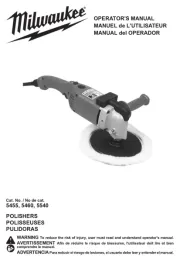
14 Juli 2025
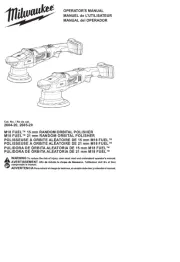
14 Juli 2025
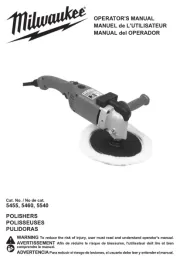
14 Juli 2025
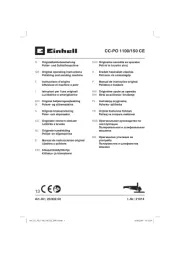
5 Juli 2025
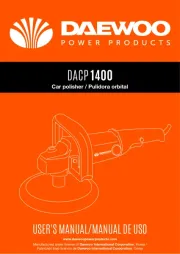
4 Juli 2025
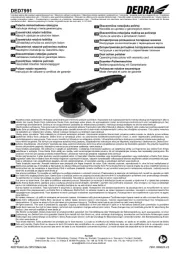
4 Juli 2025
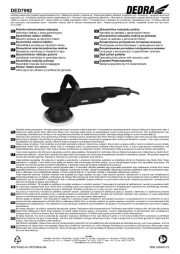
2 Juli 2025
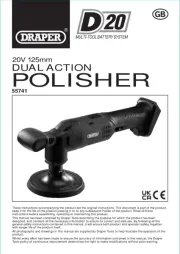
30 Mei 2025
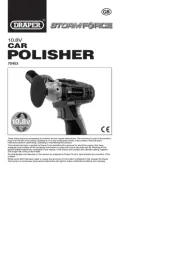
30 Mei 2025
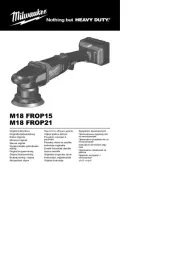
4 April 2025